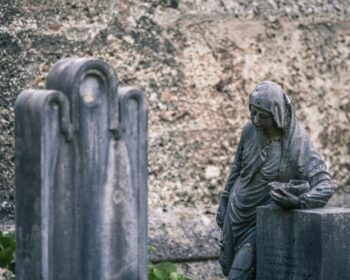
The Office of Widow on the Early Church
As I’ve done some speaking and writing about 1 Timothy 5, I’ve received requests for sources relating to widows as an office in the early church. Below is a short bibliography in chronological order by publication date. I recommend that you read the books in this order so you can see the development of the research:
Gryson, Roger. The Ministry of Women in the Early Church. Collegeville, MN: Liturgical Press, 1976.
Martimort, A. Georges. Deaconesses: An Historical Study. Translated by K. D. Whitehead. San Francisco: Ignatius Press, 1986.
*Thurston, Bonnie Bowman. The Widows: A Women’s Ministry in the Early Church. Minneapolis: Fortress Press, 1989. 117 pages.
Elm, Susanna. Virgins of God: The Making of Asceticism in Late Antiquity. Oxford, Clarendon Press. 1994. 444 pages.
Eisen, Ute E. Women Officeholders in Early Christianity: Epigraphical and Literary Studies. Translated by Linda Maloney. Collegeville, MN: The Liturgical Press, 2000. 322 pages.
Madigan, Kevin and Carolyn Osiek. Ordained Women in the Early Church: A Documentary History.
Baltimore: Johns Hopkins University Press, 2011. 240 pages.
Davies, Stevan L. The Revolt of the Widows: The Social World of the Apocryphal Acts. Dublin, Bardic Press, 2012. 162 pages.
*Classic work. If you have time to read only one, read this one. Thurston builds a case for the founding of an official order of widows in the New Testament scriptures (1 Tim 5), then examines the ensuing ministry of widows through the 3rd century. Her consideration of patristic-era documents includes a discussion of the cultural influences behind changes in ecclesial structures. She concludes that the order of widows was linked to spiritual gifting and reached its height in the 3rd century, especially (but not exclusively) in the Eastern Church. She concludes the order of widows was ultimately replaced by the rise of the female deacon as the church institutionalized and moved away from gift-based ministry forms to clerical offices.
Additionally, here is the relevant part of the entry from the Theological Dictionary of the NT (TDNT), the 1977 version (I’m going with an older lexicon to show that the research about widows as an institution/ office has been around for more than 45 years) about the chḗra or widow. Note that the term is not limited to women who have actually lost husbands.
Common Greek Usage. This word, meaning “widow,” derives from a root meaning “forsaken,” and it may thus refer to any woman living without a husband… The LXX. The LXX uses chḗra mainly for “widow,” although “woman without a husband” is the sense in, e.g., 2 Sam. 20:3. chēreía occurs in Is. 54:4, chēreúō in Jdt. 8:4, chḗreusis (“widow’s weeds”) in Gen. 38:14, 19….
Pastorals.
a. The Widow in the Family Unit. An early order for widows may be found in 1 Tim. 5:3ff. This order does not accept widows for service in the church or for the church’s care if they have tasks, or may be cared for, within the family. Expositors differ as to whether it is the widows who are to look after the children and grandchildren, or the children and grandchildren who are to look after the widows. Possibly both views are right and mutual obligations are at issue. Widows must not neglect their immediate duties, nor relatives their duties toward them, in favor of duties to the church and its care for widows.
b. Younger Widows. Younger widows, too, have immediate tasks, and easily fall victim to frivolity or sensuality. If they are entrusted with a widow’s office in the church, and subsequently remarry, they will break their primary loyalty to Christ. In the discharge of their duties, they also run the risk of becoming idlers and gossips [NOTE: This word “gossips” has later been deemed to have doctrinal overtones and is perhaps better rendered as “talking nonsense”– SG] and thus of bringing disrepute on the church. It is better, then, that they should remarry (5:14) and thus assume duties that will leave them less chance of getting into mischief…
d. Ministry. “True” widows are selected for service in the church (v. 9). This is implied by the “enrollment” of vv. 9, 11. Qualifications for selection are that they have no family (v. 5), give proof of good works (v. 10), be at least 60 years old (v. 9), have had only one husband (v. 9), and have no desire to remarry (v. 11). Whether the reference to one husband refers to remarriage after the death of a first husband or to remarriage after divorce is debated. Jesus allows the former but not the latter (Mk. 12:24ff.; 10:12). Paul leaves the former open in principle (Rom. 7:2–3). Lk. 2:36–37 extols the widow who has married only once. The tasks of widows include prayer, duties corresponding to those of a wife, and probably the training of younger women as enjoined on the presbýtides in Tit. 2:3ff. Wealthy widows might also have had charge of house churches (cf. Lydia, Mary the mother of Mark, Chloe, and Nympha in Col. 4:15). Relatives are to provide for widows where possible. The church assumes responsibility where there is no one else to do so (1 Tim. 5:16).
D. The Widow in the Early Church.
- 7. Widows as an Institution. An institution of widows develops, although whether they are ranked as ordained ministers is debatable. To be accepted widows must go through a time of testing, must have been married only once, must have led blameless lives and cared well for their families, and must be of a certain (variable) age. When appointed church widows, they take a vow not to remarry and are accountable to God for keeping it. In later orders there are to be only three church widows in a congregation. Some references group them with the bishops, presbyters, and deacons; others not. Ignatius [d. 108] Smyrneans 13:1 mentions “virgins who are called widows,” perhaps because there are not enough real widows. Women deacons, or deaconesses, have some precedence over widows because they have functions of supervision and direction, but they are often selected from among virgins or widows. We thus read of widows who are deaconesses, although even later the two groups are not identical. The tasks of widows include prayer, caring for the sick, visiting prisoners, showing hospitality to traveling preachers, and teaching women catechumens and Christian girls. Because of their work in the church they are highly honored, have a special place at worship on the left behind the presbyters (as deacons are on the right behind the bishop), receive communion after the deacons and before subdeacons, etc. Yet by the end of the early period the order disappears. It perhaps finds a new form in the monastic orders for women, for nuns take up many of the duties that widows originally discharge.
Madigan’s work includes these instructions for installing a widow to office from the 5th century (or 4th?) document from Syria (or Egypt? Asia Minor?), the Testamentum Domini:
Testamentum Domini 1.41 (Prayer of the Widows Who Sit in Front)
Following are the instructions for the ordination of a widow and the prayer the bishop says in ordaining her. The ordination (ordinatio) of a widow should occur like this: While she is praying at the entrance of the altar and looking downward, let the bishop say quietly (submisse), so that only the priests may hear: Holy and lofty God, who sees humble women, who has chosen the infirm and the powerful, who has created, O honored one, even these who are scorned, impart, O Lord, a spirit of power upon this your servant, and in your truth strengthen her so that, fulfilling your commandment and laboring in your sanctuary, she may be for you an honored vessel and may give glory on the day, O Lord, on which you will glorify your poor ones. Give to her power of happily practicing the teachings prescribed by you in the rule of your handmaiden. Give to her, O Lord, a spirit of humility, of power and patience and kindness, so that she might, bearing your burden with ineffable joy, sustain her labors. Truly, Lord God, who knows our infirmity, perfect your handmaiden for the glory of your house; strengthen her for edification and as a shining example. God, sanctify her, make her wise and comfort her, because, God our Father, your kingdom is blessed and glorious . . .
The people: Amen.



